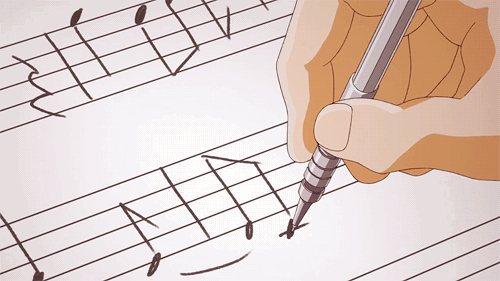
Week 6
Technology and Sound
LESSON 1
Technology has had a huge influence on the way composers write music. Think back to the influence of Techno (back in Week 2). Sound production can greatly change the quality of sounds, making them seem unfamiliar.
Listen to Aviva Endeans and Evelyn Ida Morris' Speak To Me from Crush Crush, and Paul Kelly and James Ledger's The Chimes at Midnight from Conversations with Ghosts.
Both pieces are based on loops. In your EverNote:
-
Which instruments are playing these loops?
-
What is the role of the loops in the piece?
The 2 loops used in Speak To Me and Chimes At Midnight have been notated for you. Play them on your instruments to see how they sound.
In these two pieces, how has the sound quality of the instruments been changed? What effects have been added to change their sound quality?
Rush loops
While loops aren't used in Rush, a loop-like effect is created through the repeating rhythmic cycles and poly-rhythms.

Week 6

Onomatopoeia
Onomatopoeia is a work by Nigel Westlake, for bass clarinet and digital delay.
In your EverNote, Discuss how the digital delay changes various aspects of the composition, including tone colour and texture.
Guiding questions:
-
What is the effect of the digital delay?
-
How has the technology influenced the composer's writing for the bass clarinet?
Adding FX onto a recording on Garageband
As a demonstration, one student will play one of the loops from either Chimes At Midnight or Speak To Me, recorded into Garageband. The teacher demonstrates how to add one or two effects to the track in Garageband.
Discuss the tone colour of the loop before and after adding certain effects, Effects include: reverb, compression, tremolo, chorus, delay, and EQ/filters
Continuation and Completion of Composition Task4.
Create a recording of their composition, applying the production techniques we've discussed to your composition.
Students export recordings of their tracks with and without the effects to their EverNote, and explain the difference in the sound that the effect creates

Homework: Weekly Sight Singing
Download the Sight Singing Task.
Record an audio or video of your sight singing, and submit it to the Google Classroom submission box.
(Sight Singing example adapted from HSC 2001)
LESSON 2
Analyse your own composition on EverNote, focussing on the techniques that we have covered so far, and how it creates interest and contrast. Your composition and this analysis will be presented to 3-4 peers in Week 8 Lesson 1
To support and scaffold your analysis, you can use a Coggle mindmap, highlight certain passages of your composition, or embed recordings of your composition. I've attached a Coggle template that you can make a copy of. Alternatively, you can also create an EverNote, with one Note for each concept.
Reflect on this analysis process using a video self/written EverNote post.
-
What techniques did you use the most?
-
What was the effect intended and the actual effect caused by these features you've used?
-
Now that you've done an analysis of your own composition, how might you change it?

